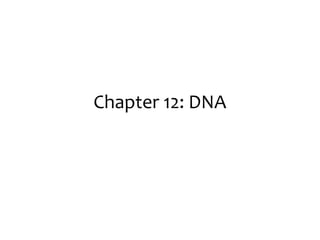Notes ch12 DNA
- 2. 12.1 The Role of DNA âĒ DNA has 3 functions: â Storing information â Copying information â Transmitting information
- 3. 12.2 The Structure of DNA âĒ DNA â deoxyribonucleic acid âĒ Nucleotides â monomers that make up a DNA molecule â 3 parts: âĒ 5 Carbon sugar (deoxyribose) âĒ Phosphate group âĒ Nitrogenous base â Adenine (A) â Guanine (G) â Cytosine (C) â Thymine (T)
- 4. Solving the Structure of DNA âEdwin Chargaff (1949) âChargaffâs Rule â[A]=[T] â[C]=[G] Adenine Thymine Guanine Cytosine 35% 45%
- 5. âĒ Rosiland Franklin used X-ray diffraction to visualize DNA structure (1952).
- 6. âĒ Watson and Crick were the first to model DNA as a double helix in 1953.
- 7. The Double Helix Model âĒ All the previous discoveries show us the structure of DNA and how DNA can function as a carrier of genetic information. âĒ Characteristics of the double helix model: â Antiparallel strands â Hydrogen Bonding â Base Pairing
- 8. Antiparallel Strands âRun in opposite directions Base Pairing âBases are held together by hydrogen bonds. Base Pairing âA bonds with T, and C bonds with G â Complimentary base pairs hydrogen bond covalent bond
- 9. Practice Base Pairing âĒ If the sequence of bases on one strand of a DNA molecule is TCGAACTGA, the sequence on the other (complimentary) strand is:
- 10. 12.3 DNA Replication âĒ Why does DNA replicate? (Hint: Think back to Mitosis) â DNA is replicated in the S phase of the cell cycle, before the cell divides.
- 11. Copying the Code âĒ Step 1 â The DNA double helix unwinds âĒ DNA helicase (enzyme). â breaks the H bonds between the bases. âĒ The areas where the double helix separates are called replication forks.
- 12. âĒ Step 2 â DNA polymerase (enzyme) moves along each DNA strand adding complimentary bases according to the base pairing rules. â DNA polymerase also proofreads the DNA molecule to reduce errors.
- 13. âĒ Step 3 â The process continues until all of the DNA has been copied. â DNA polymerase detaches.
- 14. âĒ This process produces two DNA molecules each composed of one new and one original strand. âĒ Both DNA molecules produced are identical to each other. âĒ DNA replication takes place at many points on a eukaryotic chromosome. â Allows replication to happen more quickly.



![Solving the Structure of DNA
âEdwin Chargaff (1949)
âChargaffâs Rule
â[A]=[T]
â[C]=[G]
Adenine Thymine Guanine Cytosine
35%
45%](https://image.slidesharecdn.com/notesch12-website-140408100907-phpapp01/85/Notes-ch12-DNA-4-320.jpg)









